Chapter: Fundamentals of Database Systems : Query Processing and Optimization, and Database Tuning : Algorithms for Query Processing and Optimization
Using Heuristics in Query Optimization
Using
Heuristics in Query Optimization
In this section we discuss
optimization techniques that apply heuristic rules to modify the internal
representation of a query—which is usually in the form of a query tree or a
query graph data structure—to improve its expected performance. The scanner and
parser of an SQL query first generate a data structure that corresponds to an initial query representation, which is
then optimized according to heuristic rules. This leads to an optimized query representation, which
corresponds to the query execution strategy. Following that, a query execution
plan is generated to execute groups of operations based on the access paths available
on the files involved in the query.
One of the main heuristic rules is to apply SELECT and PROJECT operations before
applying the JOIN or other binary operations,
because the size of the file resulting from a binary operation—such as JOIN—is usually a multiplicative function of the
sizes of the input files. The SELECT and PROJECT operations reduce the size of a file and hence
should be applied before a join or
other binary operation.
In Section 19.7.1 we
reiterate the query tree and query graph notations that we introduced earlier
in the context of relational algebra and calculus in Sections 6.3.5 and 6.6.5,
respectively. These can be used as the basis for the data structures that are
used for internal representation of queries. A query tree is used to represent a relational algebra or extended relational algebra expression,
whereas a query graph is used to represent a relational calculus expression. Then in
Section 19.7.2 we show how heuristic optimization rules are applied to convert
an initial query tree into an equivalent
query tree, which represents a different relational algebra expression that is more efficient to execute but
gives the same result as the original tree. We also discuss the equivalence of
various relational algebra expressions. Finally, Section 19.7.3 discusses the
generation of query execution plans.
1. Notation for Query Trees and Query
Graphs
A query
tree is a tree data structure that corresponds to a relational algebra
expression. It represents the input relations of the query as leaf nodes of the tree, and rep-resents
the relational algebra operations as internal nodes. An execution of the query
tree consists of executing an internal node operation whenever its operands are
available and then replacing that internal node by the relation that results
from executing the operation. The order of execution of operations starts at the leaf nodes, which
represents the input database relations for the query, and ends at the root node,
which represents the final operation of the query. The execution terminates when the root node operation is
executed and produces the result relation for the query.
Figure 19.4a shows a query tree (the same as
shown in Figure 6.9) for query Q2 in Chapters 4 to 6: For every project located
in ‘Stafford’, retrieve the project number, the controlling department number,
and the department manager’s last name, address, and birthdate. This query is
specified on the COMPANY relational schema in Figure 3.5 and corresponds to the
following relational algebra expression:

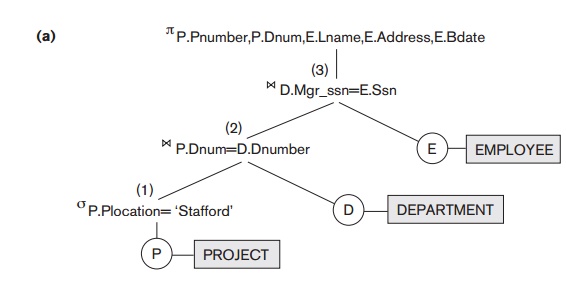
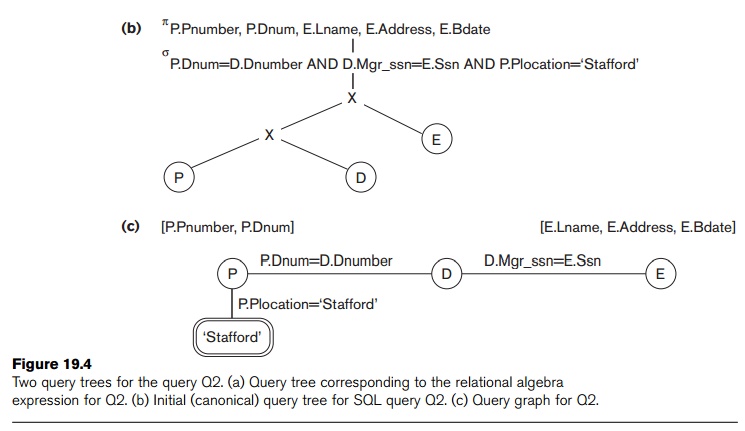
In Figure 19.4a, the leaf nodes P, D, and E represent the three relations PROJECT, DEPARTMENT, and EMPLOYEE, respectively, and the internal tree nodes
represent the relational algebra
operations of the expression. When this query tree is executed, the node
marked (1) in Figure 19.4a must begin execution before node (2) because some
resulting tuples of operation (1) must be available before we can begin
executing operation (2). Similarly, node (2) must begin executing and
producing results before node (3) can start execution, and so on.
As we can see, the query tree represents a
specific order of operations for executing a query. A more neutral data
structure for representation of a query is the query graph notation.
Figure 19.4c (the same as shown in Figure 6.13) shows the query graph for query
Q2. Relations in the query are represented by relation nodes, which are displayed as single circles. Constant
values, typically from the query selection conditions, are represented by constant nodes, which are displayed as
double circles or ovals. Selection and join conditions are represented by the
graph edges, as shown in Figure
19.4c. Finally, the attributes to be retrieved from each relation are
dis-played in square brackets above each relation.
The query graph representation does not
indicate an order on which operations to perform first. There is only a single
graph corresponding to each query. Although some optimization techniques were
based on query graphs, it is now generally accepted that query trees are
preferable because, in practice, the query optimizer needs to show the order of
operations for query execution, which is not possible in query graphs.
2. Heuristic Optimization of Query Trees
In general, many different relational algebra
expressions—and hence many different query trees—can be equivalent; that is, they can represent the same query.
The query parser will typically generate a
standard initial query tree to
correspond to an SQL query, without doing any optimization. For example, for a SELECT-PROJECT-JOIN query, such as
Q2, the initial tree is shown in Figure 19.4(b).
The CARTESIAN PRODUCT of the relations specified in the FROM clause is first applied; then the selection and join conditions of the WHERE clause are applied, followed by the projection on the SELECT clause attributes. Such a canonical query tree represents a
relational algebra expression that is very
inefficient if executed directly, because of the CARTESIAN PRODUCT (×) operations. For example, if the PROJECT, DEPARTMENT, and
EMPLOYEE relations had record sizes of
100, 50, and 150 bytes and contained 100, 20, and 5,000 tuples,
respectively, the result of the CARTESIAN PRODUCT would contain 10 million tuples of record size
300 bytes each. However, the initial query tree in Figure 19.4(b) is in
a simple standard form that can be eas-ily created from the SQL query. It will
never be executed. The heuristic query optimizer will transform this initial
query tree into an equivalent final
query tree that is efficient to execute.
The optimizer must include rules for equivalence among relational algebra
expressions that can be applied to transform the initial tree into the
final, optimized query tree. First we
discuss informally how a query tree is transformed by using heuristics, and
then we discuss general transformation rules and show how they can be used in
an algebraic heuristic optimizer.
Example of Transforming a Query. Consider the following query Q on the data-base in Figure 3.5: Find
the last names of employees born after 1957 who work on a project named ‘Aquarius’. This query can
be specified in SQL as follows:
SELECT
Lname
FROMEMPLOYEE, WORKS_ON, PROJECT
WHERE Pname=‘Aquarius’ AND Pnumber=Pno AND Essn=Ssn
AND
Bdate > ‘1957-12-31’;
The initial query tree for Q is shown in Figure 19.5(a). Executing this tree directly first
creates a very large file containing the CARTESIAN
PRODUCT of the entire EMPLOYEE,
WORKS_ON, and PROJECT
files. That is why the initial query tree is never executed, but is transformed into another equivalent tree that
is efficient to
Figure 19.5
Steps in
converting a query tree during heuristic optimization.
Initial (canonical) query tree for SQL query Q.
Moving SELECT operations down the query tree.
Applying the more restrictive SELECT operation
first.
Replacing CARTESIAN PRODUCT and SELECT with
JOIN operations.
Moving
PROJECT operations down the query tree.
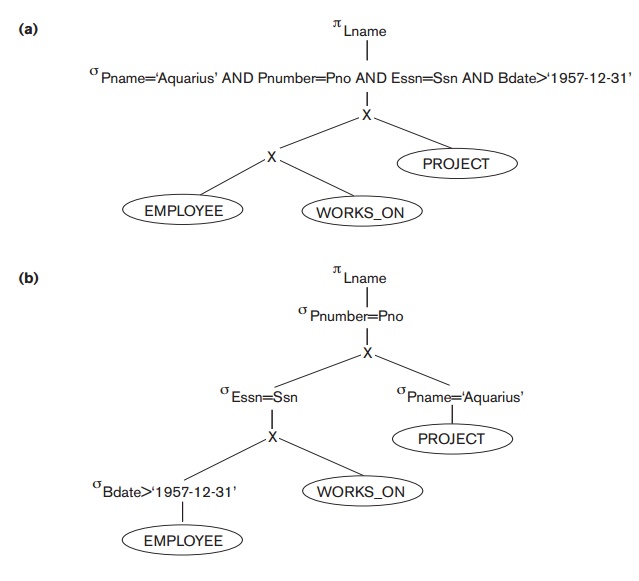
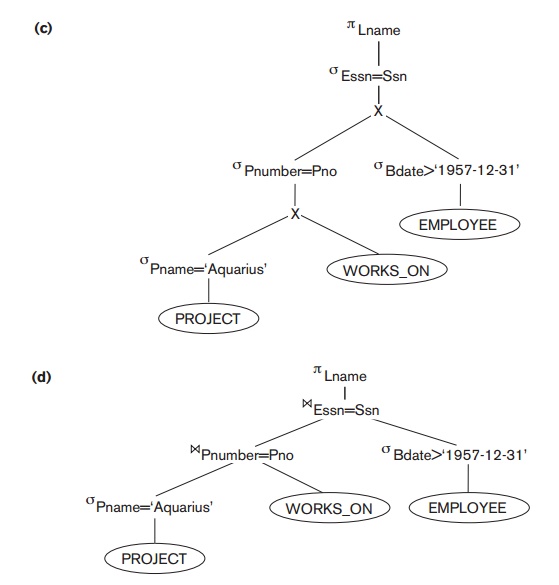
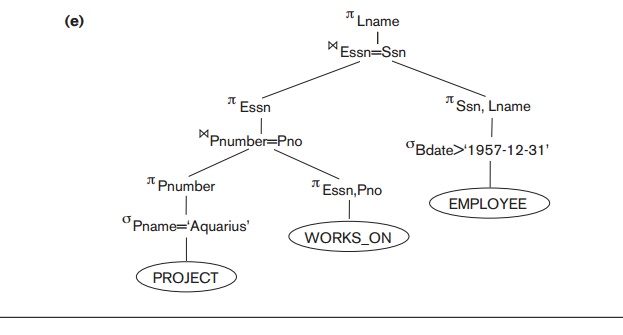
execute. This particular query needs only one
record from the PROJECT relation— for the ‘Aquarius’ project—and only
the EMPLOYEE records for those whose date of birth is after ‘1957-12-31’.
Figure 19.5(b) shows an improved query tree that first applies the SELECT operations to reduce the number of tuples that appear in the CARTESIAN PRODUCT.
A further improvement is achieved by switching
the positions of the EMPLOYEE and PROJECT relations in the tree, as shown in Figure
19.5(c). This uses the information that Pnumber is a key attribute of the PROJECT relation, and hence the SELECT operation on the PROJECT relation will retrieve a single record only. We can further
improve the query tree by replacing any CARTESIAN
PRODUCT operation that is followed by a join condition
with a JOIN operation, as shown in Figure 19.5(d). Another improvement is to
keep only the attributes needed by subsequent operations in the intermediate
relations, by including PROJECT (π) operations as early as possible in the query
tree, as shown in Figure 19.5(e). This reduces the attributes (columns) of the
intermediate relations, whereas the SELECT operations reduce the number of tuples
(records).
As the preceding example demonstrates, a query
tree can be transformed step by step into an equivalent query tree that is more
efficient to execute. However, we must make sure that the transformation steps
always lead to an equivalent query tree. To do this, the query optimizer must
know which transformation rules preserve
this equivalence. We discuss some of
these transformation rules next.
General Transformation Rules for Relational
Algebra Operations. There
are many rules for transforming relational algebra operations into
equivalent ones. For query optimization purposes, we are interested in the
meaning of the operations and the resulting relations. Hence, if two relations
have the same set of attributes in a different
order but the two relations represent the same information, we consider the
relations to be equivalent. In Section 3.1.2 we gave an alternative definition
of relation that makes the order of
attributes unimportant; we will use this definition here. We will state some transformation rules that are useful in
query optimization, without proving them:
Cascade of σ A conjunctive selection condition can be broken
up into a cascade (that is, a sequence) of individual σ operations:
σc1 AND c2 AND . . . AND cn(R) ≡ σc1 (σc2 (...(σcn(R))...))
Commutativity of σ. The σ operation is commutative: σc1 (σc2(R)) === σc2 (σc1(R))
Cascade of π. In a cascade (sequence) of
π operations, all but the last one can be ignored:
πList1 (πList2 (...(πListn(R))...))≡πList1(R)
Commuting σ with π. If the selection condition
c involves only those attributes A1, . . . , An
in the projection list, the two operations can be commuted:
πA1, A2, ..., An (σc (R))≡σc (πA1, A2, ..., An (R))
Commutativity of >< (and ×). The join operation is commutative, as is the × operation:
>< c S ≡ S >< c R
× S ≡ S × R
Notice that although the order of attributes
may not be the same in the relations resulting from the two joins (or two
Cartesian products), the meaning is
the same because the order of attributes is not important in the alternative
definition of relation.
Commuting σ with ><
(or ×). If all the attributes in the selection
condition c involve only the attributes of one of the relations being
joined—say, R—the two operations can be commuted as follows:

Alternatively, if the selection condition c can be written as (c1 AND c2), where
condition c1 involves only
the attributes of R and condition c2 involves only the
attributes of S, the operations
commute as follows:

The same rules apply if the >< is replaced by a × operation.
Commuting π with ><
(or ×). Suppose that the projection list is L = {A1,
..., An, B1,
..., Bm} , where A1, ..., An are attributes of
R and B1, ..., Bm are attributes of S. If the join condition c involves only attributes in L, the two operations can be commuted
as follows:

If the join condition c contains additional attributes not in L, these must be added to the projection list, and a final π operation is needed. For example, if attributes An+1, ..., An+k of R and Bm+1, ..., Bm+p of S are involved
in the join condition c but are not
in the projection list L, the
operations commute as follows:

For x, there is no condition c, so the first transformation rule always applies by replacing >< c with ×.
Commutativity of set operations. The set operations ∪ and ∩ are commutative but − is not.
Associativity of >< , ×, ∪, and ∩. These four operations are individually associative; that is, if θ stands for any one of these four operations
(through-out the expression), we have:
(R θ S) θ T ≡ R θ (S θ T)
Commuting σ with
set operations. The σ operation commutes with ∪, ∩, and −. If θ stands for any one of these three operations
(throughout the expression), we have:
σc (R θ S) ≡ (σc (R)) θ (σc (S))
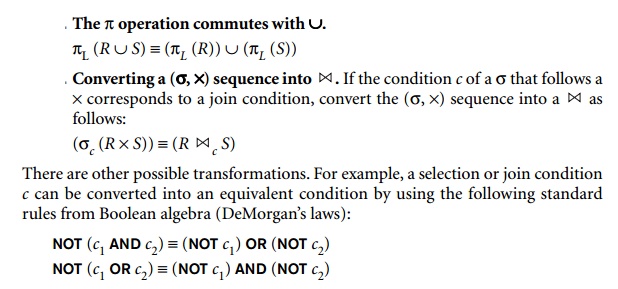
Additional transformations discussed in
Chapters 4, 5, and 6 are not repeated here. We discuss next how transformations
can be used in heuristic optimization.
Outline of a Heuristic Algebraic Optimization
Algorithm. We can now out-line the steps
of an algorithm that utilizes some of the above rules to transform an initial
query tree into a final tree that is more efficient to execute (in most cases).
The algorithm will lead to transformations similar to those discussed in our
example in Figure 19.5. The steps of the algorithm are as follows:
1.
Using
Rule 1, break up any SELECT operations with conjunctive conditions into a
cascade of SELECT operations. This permits a greater degree of freedom in moving SELECT operations down different branches of the tree.
2.
Using
Rules 2, 4, 6, and 10 concerning the commutativity of SELECT with other operations, move each SELECT operation as far down the query tree as is
permitted by the attributes involved in the select condition. If the condition
involves attributes from only one table,
which means that it represents a selection
condition, the operation is moved all the way to the leaf node that represents this table. If the condition
involves attributes from two tables,
which means that it represents a join
condition, the condition is moved to a location down the tree after the two
tables are combined.
3.
Using
Rules 5 and 9 concerning commutativity and associativity of binary operations,
rearrange the leaf nodes of the tree using the following criteria. First,
position the leaf node relations with the most restrictive SELECT operations so they are executed first in the query tree
representation. The definition of most
restrictive SELECT can mean either the ones that produce a
relation with the fewest tuples or with the smallest absolute size.17
Another possibility is to define the most restrictive SELECT as the one with the small-est selectivity; this is more practical
because estimates of selectivities are often available in the DBMS catalog.
Second, make sure that the ordering of leaf nodes does not cause CARTESIAN PRODUCT operations; for example, if the two relations with the most
restrictive SELECT do not have a direct join condition between them, it may be
desirable to change the order of leaf nodes to avoid Cartesian products.
4.
Using
Rule 12, combine a CARTESIAN PRODUCT operation with a subsequent SELECT operation in the tree into a JOIN operation, if the condition represents a join
condition.
5.
Using
Rules 3, 4, 7, and 11 concerning the cascading of PROJECT and the commuting of PROJECT with other operations, break down and move
lists of projection attributes down the tree as far as possible by creating new
PROJECT operations as needed. Only those attributes needed in the query result and in subsequent operations in the
query tree should be kept after each PROJECT operation.
6.
Identify
subtrees that represent groups of operations that can be executed by a single
algorithm.
In our example, Figure 19.5(b) shows the tree
in Figure 19.5(a) after applying steps 1 and 2 of the algorithm; Figure 19.5(c)
shows the tree after step 3; Figure 19.5(d) after step 4; and Figure 19.5(e)
after step 5. In step 6 we may group together the operations in the subtree
whose root is the operation πEssn into a single algorithm. We may
also group the remaining operations into another subtree, where the tuples
resulting from the first algorithm replace the subtree whose root is the
operation πEssn, because the first grouping means that this subtree is executed
first.
Summary of Heuristics for Algebraic
Optimization. The main heuristic is to apply first the operations that reduce the size of intermediate
results. This includes performing as early as possible SELECT operations to reduce the number of tuples and PROJECT operations to reduce the number of attributes—by moving SELECT and PROJECT operations as far down the tree as possible.
Additionally, the SELECT and JOIN operations that are most restrictive—that is,
result in relations with the fewest tuples or with the smallest absolute
size—should be executed before other similar operations. The latter rule is
accomplished through reordering the leaf nodes of the tree among themselves
while avoiding Cartesian products, and adjusting the rest of the tree
appropriately.
3. Converting Query Trees into Query
Execution Plans
An execution plan for a relational algebra
expression represented as a query tree includes information about the access
methods available for each relation as well as the algorithms to be used in
computing the relational operators represented in the tree. As a simple
example, consider query Q1 from Chapter 4, whose corresponding relational
algebra expression is
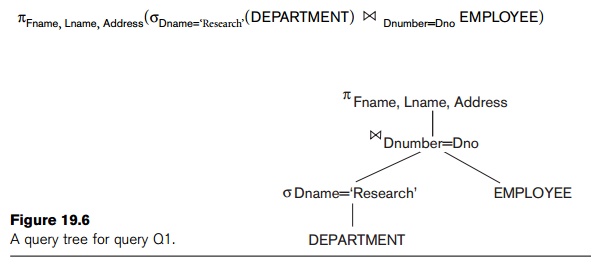
The query tree is shown in Figure 19.6. To
convert this into an execution plan, the optimizer might choose an index search
for the SELECT operation on DEPARTMENT (assuming one exists), a single-loop join
algorithm that loops over the records in the result of the SELECT operation on DEPARTMENT for the join operation (assuming an index
exists on the Dno attribute of EMPLOYEE), and a scan of the JOIN result for input to the PROJECT operator. Additionally, the approach taken for
executing the query may specify a materialized or a pipelined evaluation,
although in general a pipelined evaluation is preferred whenever feasible.
With materialized
evaluation, the result of an operation is stored as a temporary relation
(that is, the result is physically
materialized). For instance, the JOIN operation can be computed and the entire
result stored as a temporary relation, which is then read as input by the
algorithm that computes the PROJECT operation, which would produce the query
result table. On the other hand, with pipelined
evaluation, as the resulting tuples
of an operation are produced, they are forwarded directly to the next operation in the query sequence. For example,
as the selected tuples from DEPARTMENT are produced by the SELECT operation, they are placed in a buffer; the JOIN operation algorithm would then consume the tuples from the buffer,
and those tuples that result from the JOIN operation are pipelined to the projection
operation algorithm. The advantage of pipelining is the cost savings in not
having to write the intermediate results to disk and not having to read them
back for the next operation.
Related Topics